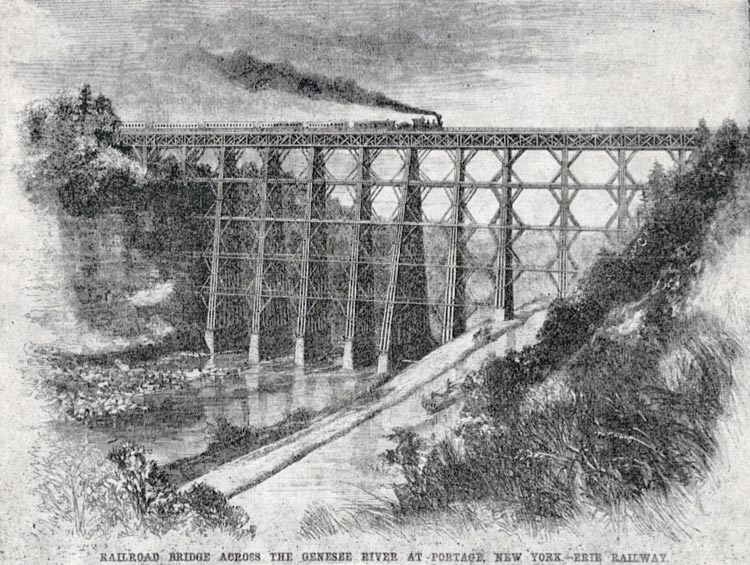
Engraving from Scientific American Magazine, 1867. Image source: Sketch of William Pryor Letchworth and Glen Iris
By the mid-1840s, commerce dictated that construction of a railroad bridge over the Genesee River was necessary if there was to be a rail link between Buffalo and New York City. After years of trying to secure investors, backers finally formed the Buffalo and New York City Railroad for the purpose of constructing a rail line between Attica and Hornellsville. The Genesse gorge location for the necessary bridge was 250 feet deep and 900 feet wide. A "congress of engineers" [Mott, Erie Railroad historian] was needed to devise a design. Silas Seymour was placed in charge of the final design and construction, which took nearly two years and required all the timber from 205 acres of heavily timbered land, 1,600,000 feet of lumber. Its stone piers were of 10,000 yards of masonry. The iron to hold it together weighed 108,862 lbs. The dangerous work of construction from 1850-1852 was carried out by Irish workmen; it was a point of pride that no one died during on the job. Total cost of the bridge and a station on the east bank was $200,000 ($5,855,023 in 2016 dollars).
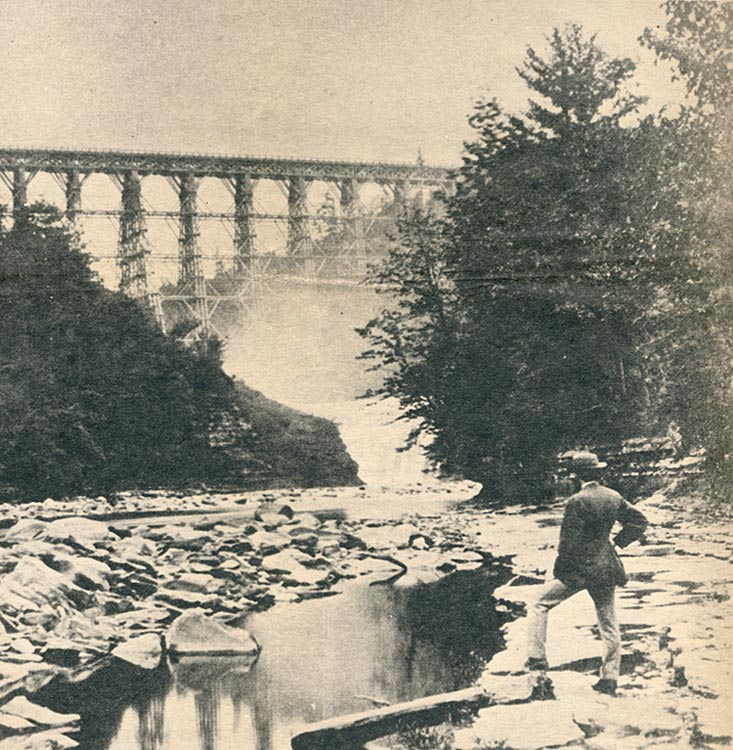
Looking from the flats between the Upper and Middle Falls. Image source: Courier-Express
The opening of the bridge in August, 1852, was celebrated in grand style. Some accounts say that 10,000 people gathered to watch the first train, loaded with the governor and lieutenant governor and presidents of several railways, as it crossed the new bridge. "When the train arrived directly over the river, and 240 feet above it, the people on board, and those on the bank, sent up such a shout as drowned even the roar of the falls, and as the train passed on, the cheers continued, amid the whirling of hats by the men, and the waving of handkerchiefs by the ladies who were scattered over the east bank and filled the balconies and windows fo the Mountain House." [unidentified contemporary account] A great feast was held on the flats between the Upper and Middle Falls.
The bridge was instantly hailed as the highest and longest bridge in the world and became a magnet for tourists. An ad in 1853 for the Buffalo & New York and Erie Railroads added a special note: "N.B. Pleasure seekers desirous of visiting Portage Falls and the High Bridge can leave Buffalo on the Lightening train at 6:15 or Mail at 9:35 A.M., and returning, leave Portage at 5:35 and arrive in Buffalo at 9:00, giving them over nine hours at Portage for the enjoyment of scenery unsurpassed in wild and picturesque beauty and sublimity." The railroads had also thoughtfully constructed Cascade House to serve sightseers.
As many as twenty trains a day crossed the wooden bridge in both directions.
Letchworth Biographer J. N. Larned said the wooden bridge "was a wonderfully effective adjunct of the scenery, filling, as it did, the whole opening between the walls of the river by the lattice-like structure of its timber trestles, and seeming to be just a great gate, hung with no other design than to shut out the external world." He was referring to the gorge during the time his friend William Pryor Letchworth owned it and lived there for much of his later life.
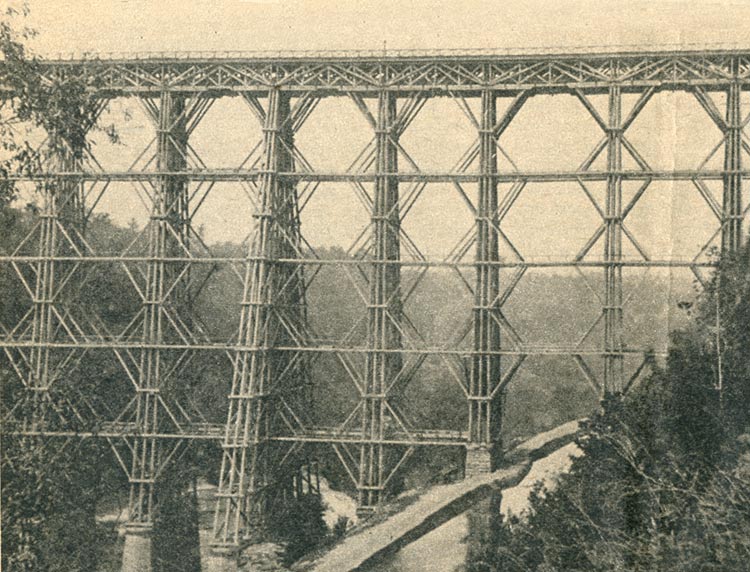
The wooden bridge showing construction. Image source: Courier-Express
The bridge design's genius was in its ease of maintenance. It was designed so that any timber could be removed and replaced without interruption of rail service across the span. Its weakness was that it was constructed of wood during a time when coal sparks were discharged from the smokestacks of locomotives. To guard against fire, the bridge had water barrels at each end, hoses supplied by a spring, and a watchman at the Portage station whose duty it was to walk the entire bridge after a train had passed. Unfortunately, on May 6, 1875, 23 years after it opened, a fire began on the bridge surface after midnight; the water supply lines could not be turned on because of rusting on the wheel. And the bridge, with its dry timbers, began to burn quickly.
Three hours later, William Pryor Letchworth, awoke in his Glen Iris home to see the bridge burning. He wrote in his account published in the Buffalo Courier: "I was aroused from sleep at ten minutes to four, and in a few minutes was standing on the lawn at Glen Iris, from which point every portion of the bridge was visible, as well as the Upper Falls, the river, and the Middle Falls. The spectacle...was fearfully grand; every timber in the bridge seemed then to be ignited, and an open network of fire was stretched across the upper end of the valley. Above the bridge and touching its upper line a black curtain hung down from the sky, its lower edge belted with a murky fringe of fire. The hoarse growl of the flames and the crackling of the timbers sounded like a hurrican approaching through the forest. At this time the Upper Falls seemed dancing in a silver light. The water in the river was glistening with the bright glare thrown on it, and the whole valley of the Glen Iris was illuminated with tragic splendor..." Twenty minutes after he arose to see the flames, the entire bridge collapsed into the Genesee, leaving only the stone piers.

The rail line was so important to the Erie Railroad that a contract to construct a new iron bridge was let to the Watson Manufacturing Company four days after the fire. The old stone piers were used after being widened, and 1.3 million pounds of iron girders were raised in Erie Railroad engineer George Morison's design. The new bridge, 20 feet higher than the old, was constructed at a cost of $80,000. It took only 84 days to complete, finishing on July 29, 1875. There was no great celebration. The new bridge seemed to lack the poetry of the old wooden structure. "The towers appear light and graceful without being frail, and while the bridge will not be so massive or wonderfully impressive as the wooden one was, it will be nevertheless as attractive in its way, and will, we think, mark the line of the furthest advance in iron bridge-building, meeting the standard requirements of perfect safety, endurance, quickness of construction and cheapness." [unidentified contemporary account].
In 1903, 260 tons of the iron was replaced with steel; remodeling continued through the 20th century. In 2017, the bridge continues to be used. A new span is being constructed beside it and is expected to be operational before the end of the year. The old bridge will be dismantled.
According to the Norfolk Southern, "The $70-million railroad bridge, which spans the Genesee River Gorge in Letchworth State Park near Castile, N.Y., is a public-private partnership among Norfolk Southern, the New York State Department of Transportation, and the New York State Office of Parks, Recreation, and Historic Preservation."
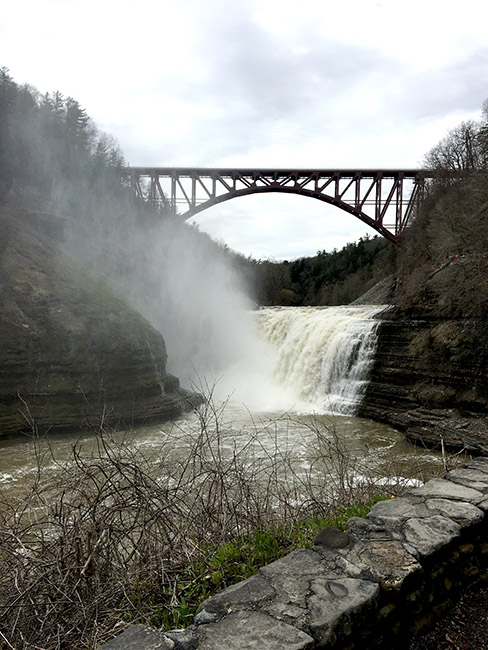
Completed bridge May 2020
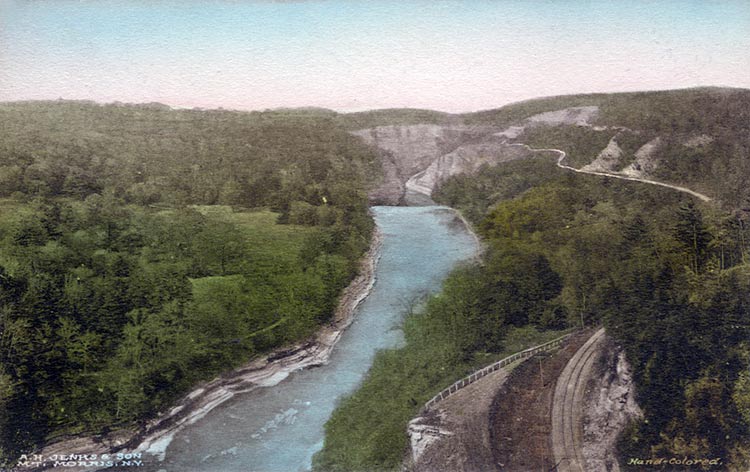
Looking from the bridge toward the Middle Falls, c. 1900. Image source: private collection
The view above was similar to what William Pryor Letchworth saw from his train in 1857, except that by the time this photo was taken, Letchworth had replanted trees and restored the gorge to its idyllic state.
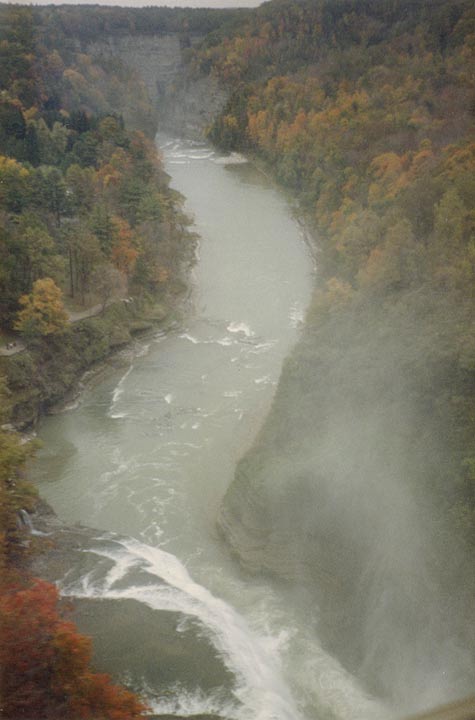
1987 view from the bridge, Upper Falls at bottom, Middle Falls at top. Taken during a train excursion given by the Western New York Railway Historical Society..